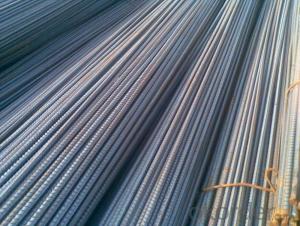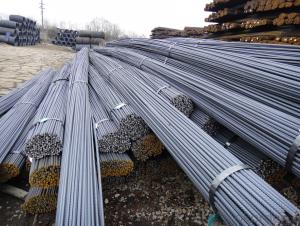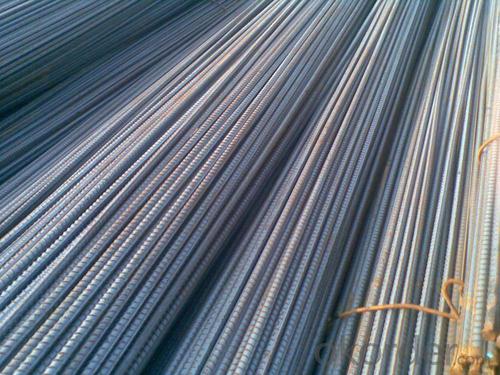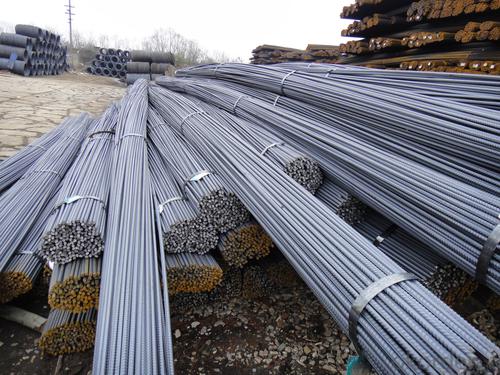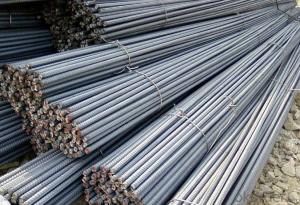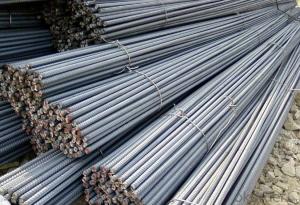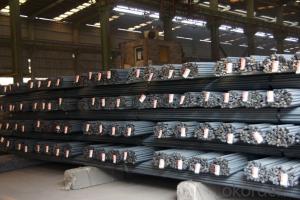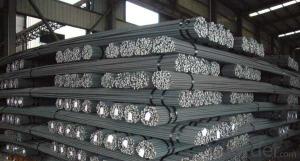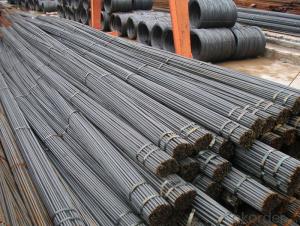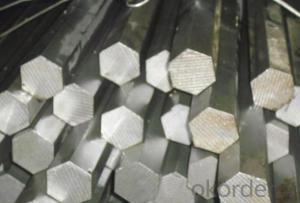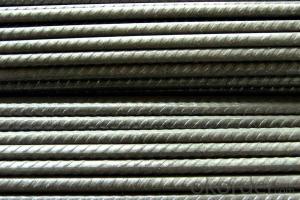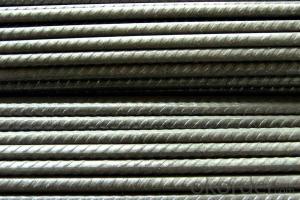Hot Rolled Carbon Steel Deformed Bar 16-25mm with High Quality
- Loading Port:
- China Main Port
- Payment Terms:
- TT or LC
- Min Order Qty:
- 25 m.t.
- Supply Capability:
- 15000 m.t./month
OKorder Service Pledge
OKorder Financial Service
You Might Also Like
Product Description:
OKorder is offering Hot Rolled Carbon Steel Deformed Bar 16-25mm with High Quality at great prices with worldwide shipping. Our supplier is a world-class manufacturer of steel, with our products utilized the world over. OKorder annually supplies products to European, North American and Asian markets. We provide quotations within 24 hours of receiving an inquiry and guarantee competitive prices.
Product Applications:
Hot Rolled Carbon Steel Deformed Bar 16-25mm with High Quality is widely used in buildings, bridges, roads and other engineering construction. Big to highways, railways, bridges, culverts, tunnels, public facilities such as flood control, dam, small to housing construction, beam, column, wall and the foundation of the plate, deformed bar is an integral structure material. With the development of world economy and the vigorous development of infrastructure construction, real estate, the demand for deformed bar will be larger and larger..
Product Advantages:
OKorder's Hot Rolled Carbon Steel Deformed Bar 16-25mm with High Quality are durable, strong.packed and suitable for construction
Main Product Features:
· Premium quality
· Prompt delivery & seaworthy packing (30 days after receiving deposit)
· Can be recycled and reused
· Mill test certification
· Professional Service
· Competitive pricing
Product Specifications:
Manufacture: Hot rolled
Grade: HRB335 HRB400 BS4449 Grade460 ASTM Grade40 Grade60
Certificates: ISO, SGS, BV, CIQ
Length:6m 8m 9m 12m
Packaging: Export packing, packed by coil
FAQ:
Q1: Why buy Materials & Equipment from OKorder.com?
A1: All products offered byOKorder.com are carefully selected from China's most reliable manufacturing enterprises. Through its ISO certifications, OKorder.com adheres to the highest standards and a commitment to supply chain safety and customer satisfaction.
Q2: How do we guarantee the quality of our products?
A2: We have established an advanced quality management system which conducts strict quality tests at every step, from raw materials to the final product. At the same time, we provide extensive follow-up service assurances as required.
Q3: How soon can we receive the product after purchase?
A3: Within three days of placing an order, we will begin production. The specific shipping date is dependent upon international and government factors, but is typically 7 to 10 workdays.
Q4: How many tons per bundle?
A4: Around 2-3tons
Q5: How to avoid the rust after deliver the goods to the loading port?
A5: We will keep the goods at the port covered with water-proof material
Q6: What is the chemical composition and physical properties of HRB400?
A6:
Grade | Technical data of the original chemical composition (%) | ||||||
C | Mn | Si | S | P | V | ||
HRB400 | ≤0.25 | ≤1.60 | ≤0.80 | ≤0.045 | ≤0.045 | 0.04-0.12 | |
Physical capability | |||||||
Yield Strength (N/cm²) | Tensile Strength (N/cm²) | Elongation (%) | |||||
≥400 | ≥570 | ≥14 | |||||
Images:
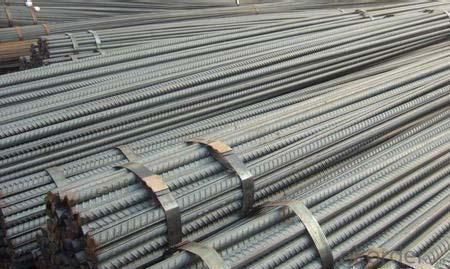
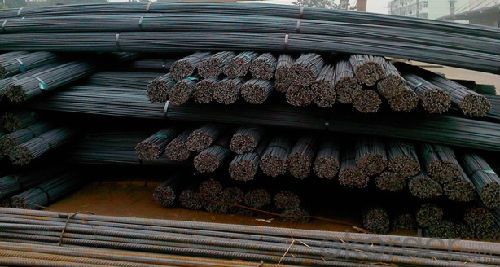
- Q: How do steel rebars improve the strength and durability of concrete?
- Steel rebars improve the strength and durability of concrete in several ways. Firstly, rebars provide reinforcement to the concrete structure, increasing its tensile strength. Concrete is excellent at withstanding compression forces, but it is relatively weak when it comes to tension. By embedding steel rebars within the concrete, the tensile strength of the structure is significantly enhanced. This means that the concrete can resist bending, cracking, and collapsing under heavy loads or external forces. Secondly, steel rebars prevent cracking and shrinkage in the concrete. Concrete tends to shrink as it dries and cures, leading to the development of cracks. However, rebars help to control and restrict this shrinkage by providing additional support and structural integrity. This helps to minimize the occurrence of cracks and ensures that the concrete remains strong and durable over time. Furthermore, steel rebars improve the overall structural stability of the concrete. When concrete is subjected to dynamic loads or seismic activity, it can experience significant deformation or even failure. The presence of rebars helps to distribute the load more evenly throughout the concrete structure, reducing the risk of localized damage or collapse. This enhances the overall stability and safety of the concrete construction. Lastly, steel rebars increase the longevity and durability of concrete structures. The steel used in rebars is highly resistant to corrosion, which is a common issue in concrete exposed to harsh environmental conditions or moisture. By providing a protective layer around the steel, known as passivation, rebars prevent corrosion and maintain the structural integrity of the concrete for an extended period. This ensures that the concrete remains strong, durable, and resistant to degradation over its lifespan. In summary, steel rebars play a crucial role in improving the strength and durability of concrete. They enhance the tensile strength, prevent cracking and shrinkage, enhance structural stability, and increase the longevity of the concrete structure. With the addition of steel rebars, concrete becomes a reliable and long-lasting construction material capable of withstanding various loads and environmental conditions.
- Q: Can steel rebars be used in structures with curved or irregular shapes?
- Structures with curved or irregular shapes can indeed utilize steel rebars. Owing to their remarkable flexibility, steel rebars can be easily bent or molded to accommodate the desired structure form. They find extensive application in reinforced concrete structures, where architectural or structural design calls for curved or irregular shapes. Typically, the rebars are bent or trimmed as per the required configuration and then firmly fastened in position to impart robustness and reinforcement to the structure. Consequently, this facilitates the construction of intricate structures with sophisticated designs, all while guaranteeing their steadfast structural integrity and longevity.
- Q: Are steel rebars suitable for use in sports stadium construction?
- Yes, steel rebars are suitable for use in sports stadium construction. Steel rebars provide excellent strength and durability, making them ideal for reinforcing concrete structures, such as stadiums, that need to withstand heavy loads and impacts. They enhance the structural integrity of the stadium, ensuring its safety and long-term stability. Additionally, steel rebars offer flexibility in design and can be customized to meet specific construction requirements, making them a preferred choice in sports stadium construction.
- Q: What is the role of steel rebars in the construction of power transmission towers?
- The role of steel rebars in the construction of power transmission towers is to provide structural reinforcement and strength to the concrete foundations and columns. Steel rebars act as a framework within the concrete, helping to distribute the load and withstand the forces exerted on the towers, including wind, seismic activity, and the weight of the transmission lines. They enhance the overall stability and durability of the towers, ensuring their ability to safely support and transmit electrical power.
- Q: What is the process of handling and transporting steel rebars on-site?
- Ensuring the safe and efficient movement of steel rebars on-site involves a series of steps. To begin, the construction site receives the steel rebars, unloading them from the delivery truck and inspecting for any damage or defects. Once unloaded, the rebars are stored in a designated rebar yard, where they are arranged and stacked for easy access and protection against damage or tangling. Depending on the construction project's requirements, the rebars may be cut or bent to a specific shape before installation, utilizing specialized tools and equipment. After cutting and bending, the rebars are transported to the designated work area on the construction site. This can be done manually by workers or with the assistance of mechanical equipment like cranes or forklifts for larger quantities. In the work area, the rebars are installed according to the project's design and specifications, being placed within the appropriate positions in the concrete structure. Throughout the entire process, strict adherence to safety guidelines is crucial to prevent accidents or injuries. This includes wearing protective gear and ensuring that the rebars are handled and transported in a manner that minimizes the risk of tripping or falling. Regular inspections should also be conducted to detect any damage or defects, as these can compromise the structural integrity of the construction project.
- Q: Can steel rebars be used in structures with limited construction technology?
- Yes, steel rebars can be used in structures with limited construction technology. Steel rebars are commonly used in construction to reinforce concrete structures, providing strength and durability. They are versatile and can be used in various types of structures, such as buildings, bridges, and dams. In areas with limited construction technology, the use of steel rebars can still be feasible. The basic process of placing rebars involves bending and cutting them to the required sizes and shapes, and then placing them within the concrete forms before pouring the concrete. This process can be carried out using basic tools and equipment that are typically available in construction sites with limited resources. Additionally, the availability of steel rebars in various sizes and grades allows for flexibility in design and construction, making them suitable for a wide range of structures. The use of steel rebars ensures that the concrete structure can withstand various loads and forces, enhancing its overall strength and durability. While the availability of advanced construction technology may enhance the efficiency and precision of the construction process, it is not a prerequisite for using steel rebars. With proper training and expertise, construction workers can effectively use steel rebars in structures, even with limited technology, to create safe and reliable structures.
- Q: What are the common quality control tests for steel rebars?
- There are several common quality control tests conducted on steel rebars to ensure their compliance with industry standards and specifications. These tests help assess the physical, mechanical, and chemical properties of the rebars, ensuring their durability and performance. Some of the common quality control tests for steel rebars include: 1. Tensile Test: This test determines the tensile strength, yield strength, and elongation of the rebars. It involves applying a gradually increasing force to the rebar until it fractures, measuring the maximum force it can withstand before breaking. 2. Bend Test: This test evaluates the rebars' ability to withstand bending without cracking or breaking. The steel rebar is bent to a specific angle and checked for any visible cracks or fractures. 3. Chemical Composition Analysis: This test determines the chemical composition of the steel rebars, ensuring they meet the required standards. It involves analyzing the levels of carbon, manganese, phosphorus, sulfur, and other elements present in the rebar. 4. Visual Inspection: This test involves a visual examination of the rebars to ensure they are free from surface defects, such as cracks, splits, or any other irregularities that may affect their structural integrity. 5. Dimensional Inspection: This test verifies the dimensions and shape of the rebars, checking for any deviations from the specified requirements. It involves measuring the diameter, length, and shape of the rebars using calibrated instruments. 6. Weldability Test: In case the rebars are intended for welding purposes, a weldability test is performed to assess their suitability for welding. This test involves welding the rebars and evaluating the quality of the weld joint, including factors like strength, porosity, and brittleness. 7. Corrosion Resistance Test: This test determines the rebars' resistance to corrosion, which is crucial for their long-term durability. It involves subjecting the rebars to accelerated corrosion conditions, such as exposure to corrosive environments or salt spray, and assessing their corrosion resistance. These quality control tests play a vital role in ensuring the quality and reliability of steel rebars used in construction projects. By conducting these tests, manufacturers and inspectors can identify any non-compliant or substandard rebars, ensuring the safety and structural integrity of the buildings and infrastructure where these rebars are used.
- Q: Can steel rebars be used in cold storage construction?
- Yes, steel rebars can be used in cold storage construction. Steel rebars are widely used in construction due to their high strength and durability. In cold storage construction, where low temperatures are maintained, steel rebars offer several advantages. Firstly, steel rebars have excellent thermal conductivity, which allows them to quickly adjust to the low temperatures inside the cold storage facility. This helps in maintaining a consistent temperature throughout the structure and prevents any potential expansion or contraction issues. Secondly, steel rebars have a high tensile strength, making them suitable for withstanding heavy loads and providing structural stability in cold storage construction. The cold storage facility often requires a strong framework to support the weight of products and equipment stored within. Furthermore, steel rebars are corrosion-resistant, which is particularly important in cold storage environments. The low temperatures and high humidity levels can create a favorable environment for corrosion. However, steel rebars are typically coated with epoxy or galvanized to protect them from moisture and prevent rusting. Lastly, steel rebars are readily available and cost-effective, making them a practical choice for cold storage construction projects. They can be easily sourced and fabricated to meet specific design requirements, ensuring that the structure is built to withstand the unique challenges of a cold storage environment. In conclusion, steel rebars can be effectively used in cold storage construction due to their thermal conductivity, high tensile strength, corrosion resistance, and availability. They provide the necessary structural support and durability required for the construction of cold storage facilities.
- Q: Can steel rebars be bent or shaped on-site?
- Yes, steel rebars can be bent or shaped on-site using specialized equipment or tools such as rebar benders or hydraulic benders. This allows for flexibility in adjusting the rebars to fit specific construction requirements or designs.
- Q: How are steel rebars transported to the construction site?
- Steel rebars are typically transported to the construction site using flatbed trucks or trailers. These vehicles are specifically designed to carry heavy loads and have the necessary infrastructure to secure and transport the rebars safely.
Send your message to us
Hot Rolled Carbon Steel Deformed Bar 16-25mm with High Quality
- Loading Port:
- China Main Port
- Payment Terms:
- TT or LC
- Min Order Qty:
- 25 m.t.
- Supply Capability:
- 15000 m.t./month
OKorder Service Pledge
OKorder Financial Service
Similar products
Hot products
Hot Searches
Related keywords
